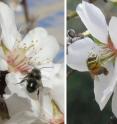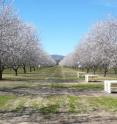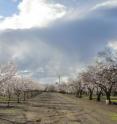2 new studies show why biodiversity is important for pollination services in California almond
Agricultural demand for pollination is growing more quickly than the supply of honey bees, the dominant species managed for crop pollination. Increasing the efficiency of pollination represents a way of increasing crop yield without any increase in agricultural intensity or area. A study recently published in the Proceedings of the Royal Society B: Biological Sciences, shows that the pollination effectiveness of honey bees in California almond orchards was greater in the presence of other bees. Almond is a crop highly dependent on honey bee pollination and is a $3 billion industry in California. The study by researchers in Germany at Leuphana University of Lüneburg and California at UC Berkeley and Davis found that where other species of bees were present, honey bee behaviour changed and their pollination effectiveness was greater than in orchards where other bees were absent. Furthermore, orchards with wild bees had a greater proportion fruit set. These findings show that wild pollinators not only contribute directly to almond pollination, but also indirectly through increasing the pollination service provided by the honey bees.
A second study in the same system published in Global Change Biology found two other mechanisms by which pollinator diversity improved pollination service to almond. Firstly, they found that honey bees preferred to visit flowers in the top parts of the almond trees. Where wild pollinators were present, they often visited the lower parts of the trees, filling the gap in pollination service left by the honey bees. Secondly, in high winds, orchards with only honey bees present had almost no pollination service as the honey bees were not flying. In orchards with a diversity of pollinators, pollination service was buffered to an extent by the wild bees.
During high winds, the wild bees were still observed visiting almond flowers. Wild pollinators can therefore help sustain pollination service under extreme weather conditions, when the service by honey bees declines. This is particularly important in almond as it flowers early in the year when the weather conditions can be unfavourable for bee flight. The findings presented in the two articles highlight different ways biodiversity is important for pollination service.
The researchers presenting the studies are Alexandra-Maria Klein and Claire Brittain from Leuphana University of Lüneburg, Claire Kremen from UC Berkeley and Neal Williams from UC Davis.
Source: Pensoft Publishers
Other sources
- Two new studies show why biodiversity is important for pollination services in California almondfrom Science DailyMon, 14 Jan 2013, 15:30:38 UTC
- Two new studies show why biodiversity is important for pollination services in California almondfrom PhysorgMon, 14 Jan 2013, 15:00:50 UTC


